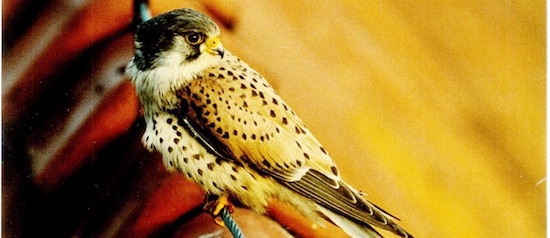
The male European Kestrel (Falco tinnunculus) from Kestrel's Eye. Photo credit: Mikael Kristersson.
Screening & Live Event
Kestrel's Eye
Saturday, October 26, 2019, 1:30 p.m.
Museum of the Moving Image - Redstone Theater
Introduced by environmental advocate and author Dr. Eric Sanderson (Mannahatta). Followed by a conversation with Dr. Sanderson and filmmaker Mikael Kristersson
Ticket purchase includes same-day admission to the Museum (see gallery hours). View the Museum’s ticketing policy here. For more information on membership and to join online, visit our membership page.
About the speakers
Mikael Kristersson is an award-winning filmmaker, director, and conservationist. Kristersson grew up on a historic farm in Falsterbo, Sweden, located a few hundred meters from world-famous Falsterbo Bird Observatory. Fascinated by the globally unique phenomenon in Falsterbo of millions of birds migrating from Northern Europe to Africa and back again, Kristersson’s artistic career has been accompanied by a lifelong dedication to environmental stewardship. His first theatrically released feature film Pica Pica (1987) achieved great success with critics and audiences and was named "Surprise of the Year" at the festival Cinema du Réel in Paris. Kristersson's second feature film, the prizewinning and critically-acclaimed Kestrel's Eye (1998), was seen by over a million cinema and television viewers, and invited to some thirty festivals worldwide. Among other awards, Kestrel's Eye received the premiere prize for documentary at the Munich, Marseilles, and at Nordisk Panorama film festivals. Kristersson's third feature film Light Year (2008) was named "Best Swedish Film of the Year, All Categories" by Sydsvenskan's critic Jan Aghed, was Sweden's nomination for the Nordic Council Film Prize 2009, and won the first prize at the science festival Mostra de Ciencia e Cinema in Spain in the same year.
Eric W. Sanderson is Senior Conservation Ecologist in the Global Conservation Programs of the Wildlife Conservation Society (WCS), a landscape ecologist, and a conservation biologist. He is the author of Mannahatta: A Natural History of New York City (Abrams, 2009) and Terra Nova: The New World After Oil, Cars, and Suburbs (Abrams, 2013), as well as editor of several edited volumes. Dr. Sanderson began WCS's Welikia Project, an online forum on the historical ecology of the New York City region to help the public envision climate-resilient designs. He is an expert in species and landscape conservation planning. Dr. Sanderson is currently the Fellow for the New York Public Library's Dorothy and Lewis B. Cullman Center for Scholars and Writers where he is working on the sequel to Mannahatta, about the ecology of New York City prior to European colonization and urbanization.

